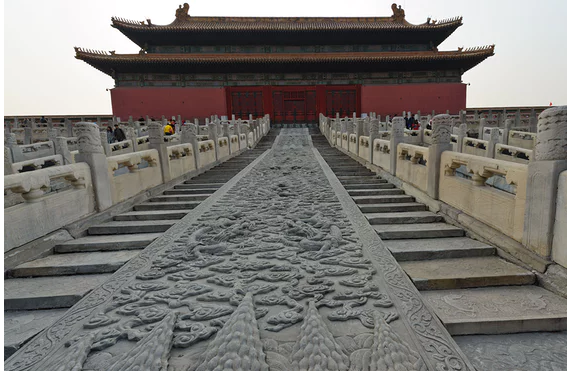
Deliberately making a road icy sounds like a bad idea for disaster, but in 16th-century China it helped things run smoothly. Repairs to the Forbidden City in Beijing in 1557 called for huge stones from a quarry(采石场) more than 70km away. The biggest was the 300-ton“Large Stone Carving”.Such stones were too heavy for any cart, and too fragile for rollers. The builders adopted a wise alternative approach to carry the heavy stone.
They dug a series of wells, spaced a few hundred metres apart, along the route to the quarry. Then, in the depth of winter, when temperatures reached around -4℃, buckets of water were poured on to the dirt track, transforming it into an ice road.
The stone blocks were pushed along the road on wooden sledges. Modern engineers have calculated that it would take 1,500 workers to drag a sledge on the dirt road, but only 300 on ice. Ancient texts suggested the ice was made slippery with more water; and this reduced the friction further and just 50 men could pull a sledge. This technique only works when the temperature is close to zero, otherwise the film of water freezes too quickly.
The researchers at Princeton University estimated that the blocks could be moved at six metres a minute, and the journey could be completed in 28 days. This would be well before the spring when the ice would melt. It was once suggested that similar ice-sledges transported Stonehenge stones, but the ground that had a lot of holes and comparatively mild conditions probably rule this out.
本时文内容由奇速英语国际教育研究院原创编写,未经书面授权,禁止复制和任何商业用途,版权所有,侵权必究!(投稿及合作联系:028-84400718 QQ:757722345)
1.What difficulty did builders meet in repairing Forbidden City?
A Making an icy road.
B Carrying the heavy stones.
C Building enough carts.
D Lacking of the quarry.
解析:选B。细节理解题。根据文章第一段第二句的Repairs to the Forbidden City in Beijing in 1557 called for huge stones from a quarry more than 70km away可以得知要整修紫禁城需要从70公里之外的地方运来巨石,所以搬运这些石头是他们面临的难题。故选B。
2.Why did people dig some wells on the way to the quarry?
A They wanted to make the dirty track clean.
B They wanted to get a lower temperature.
C They wanted to build up the road of ice.
D They wanted to break up the large stone.
解析:选C。细节理解题。根据第二段第二句的buckets of water were poured on to the dirt track, transforming it into an ice road可以得知挖井是为了把水弄到路上,等到天冷的时候,让水结冰成为一条能搬运巨石的冰路。故选C。
3.What did people do to reduce the friction?
A They waited until the temperature was very low.
B They pour small amount of water on the ice road.
C They made stone blocks become much smaller.
D They asked 1,500 workers to clean the dirty road.
解析:选B。细节理解题。根据第三段第三句的Ancient texts suggested the ice was made slippery with more water; and this reduced the friction further and just 50 men could pull a sledge. 可以得知为了让冰更光滑,他们采取了往冰上撒少许水的做法。故选B。
4.How did the researchers at Princeton University think of Stonehenge stones?
A They weren’t carried on the icy road.
B They were carried for over twenty-eight days.
C They were as big as stones in Beijing.
D They had a longer history than stones in Beijing.
解析:选A。推理判断题。根据第四段最后一句的but the ground that had a lot of holes and comparatively mild conditions probably rule this out可以得知由于地面上的坑洞和天气状况,Stonehenge stones不可能在结冰的道路上运输。故选A。